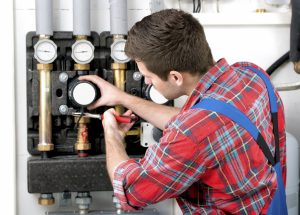
Your commercial HVAC system might be running so smoothly you take it for granted.
Whenever you enter or exit your commercial building,you might either feel a wave of hot air or a blast of cold air. This sensation can either be pleasant or jarring, depending on how the weather is outside. Your commercial HVAC system might be running so smoothly you take it for granted. But this likely means you never take the time to learn about the fundamentals of how the system works. If you are a facility manager, this is an oversight you can’t afford to indulge.
Heating Component: The Furnace
First of all, let’s take a closer look at the heating component. The heating component of any commercial HVAC system is the furnace. This critical piece of equipment is also present in HVAC units for residential buildings, but the commercial furnace is bound to be much more powerful. The furnaces rely on electricity or gas to heat up the air around it and then transfer that warm air where it needs to go inside your commercial building.
Whenever the thermostat is adjusted, that activates the pilot light. The pilot light, in turn, kicks the burners on. The heat generated by the burners is funneled through what is known as a heat exchanger before it reaches the blower motor. It’s the blower motor that moves the hot air through your facility. More heat is added until the set temperature is achieved, at which point the system comes to a stop.
Electric-powered furnaces are slightly different. Electricity passes through built-in heating elements instead of relying on a pilot light. These heating elements are connected to what are known as resistance coils. The resistance coils lead to the main air supply, where the blower motors distribute the freshly-heated air.
Cooling Component: The Air Conditioning
Next, we’ll look at the main cooling component of your commercial HVAC system. This is the air conditioning unit. Whether you work in an office or a data center, setting the proper temperatures is vital to the success of both your employees and your equipment. Air conditioners rely on four critical components:
- The evaporator
- The compressor
- The condenser
- The expansion device
However, no matter how often you reset the thermostat or the AC, you should also make sure that internal conditions aren’t too hot or too cold. That’s where the heat pump comes into play.
Heat and Cooling Component: The Pump
Heat pumps transfer the heat in a building from one room to the next and cycle the air through each area of the building. Heat pumps need an air source, a water source, or a ground source to work.
Crockett Facilities Can Help!
Crockett Facilities Services, Inc. (CFSI) is committed to helping building owners, property managers, engineers, and facility professionals lower their operating expenses through HVAC preventive maintenance. We can develop a cost-effective, customized preventive maintenance plan for your commercial building that will provide you with peace of mind, improved comfort, and energy savings.
To learn more about the importance of HVAC Preventive Maintenance, please contact us at 202.600.2787 or sales@crockett-facilities.com. Our PM contract customers receive priority service with 24/7 emergency service in Maryland, Virginia and Washington, DC.
